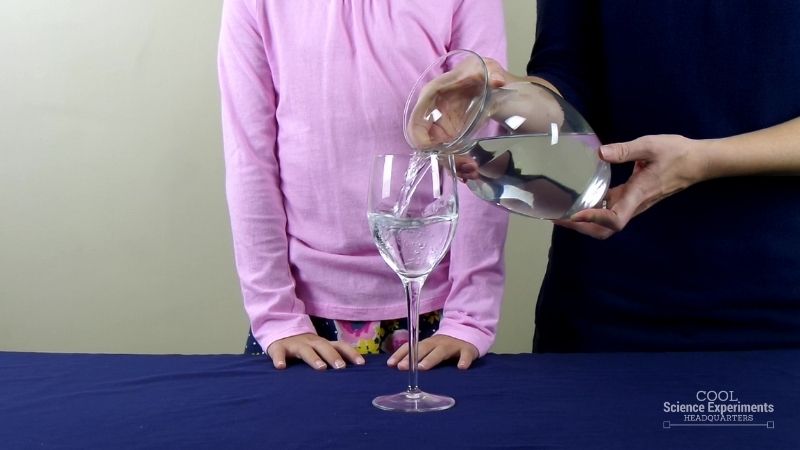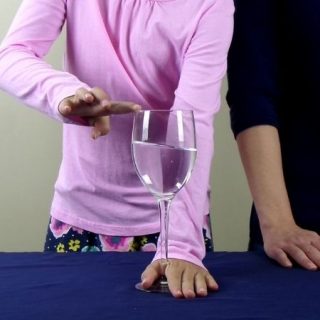Sing, wine glass, sing! Although a wine glass can’t sing by itself on command, with just a little help from you, your singing wine glass can make music!
This experiment is super easy and only needs two supplies (a wine glass and water). By changing a few variables, kids can explore and test how the pitch and volume of sound changes.
Detailed printable instructions and an easy to understand scientific explanation is included below.

JUMP TO SECTION: Instructions | Video Tutorial | How it Works | Purchase Lab Kit
Supplies Needed
Singing Wine Glass Lab Kit – Only $5
Use our easy Singing Wine Glass Science Lab Kit to grab your students’ attention without the stress of planning!
It’s everything you need to make science easy for teachers and fun for students — using inexpensive materials you probably already have in your storage closet!
Singing Glass Science Experiment Instructions

Step 1 – Start with an empty glass that has a stem. Any shape or size wine glass will work.

Step 2 – Fill the glass with water. We filled it a little more than 1/2 way full. You can experiment with different amounts of water because the quantity of water impacts the pitch of the sound.

Step 3 – Get the tip of your finger wet.

Step 4 – Hold the base of the glass stem with one hand (so it doesn’t fall over) and slowly and steadily move your wet fingertip around the rim of the glass. It may take some practice, but after a while, you should hear a singing noise.
Wondering what caused the wine glass to sing? Find out the answer in the how does this experiment work section below.
Video Tutorial
Watch the Singing Glass Science Experiment Step by Step Instructions
How Does the Singing Glass Science Experiment Work
Sound is a disturbance that travels through a medium as a wave.
In this experiment, when you rub your finger along the rim of the glass, you disturb the particles of the glass causing them to vibrate. The vibrations in the glass are transferred to the air surrounding the glass, creating a sound wave. You can actually see the vibrations of the glass if you look closely at the water in the glass (especially where the water and the glass are in contact).
Pitch is how high or low sound seems to a person and it depends on the frequency of the sound wave.
You can change the pitch of the sound produced by the amount of water you put in the glass. When you add more water to the glass, the pitch is low. This is because the high volume of water in the glass makes it more difficult for the glass particles to vibrate, so the vibrations of the glass are slower and they have a lower frequency.
When you add less water to the glass, the pitch is high. This is because the low volume of water in the glass allows the glass particle to vibrate more easily, so the vibrations of the glass are faster and have a higher frequency.
Singing Wine Glass Lab Kit – Only $5
Use our easy Singing Wine Glass Science Lab Kit to grab your students’ attention without the stress of planning!
It’s everything you need to make science easy for teachers and fun for students — using inexpensive materials you probably already have in your storage closet!
Other Ideas to Try
Try this experiment again, but use different sizes and shapes of glasses. How does this affect the glass’s ability to sing? Try using a drinking glass that is made of very thick glass. How does this glass sing compared to the wine glass? Instead of using water in the glass, try a different liquid like vegetable oil or corn syrup. Does this change the sound produced by the glass?
I hope you enjoyed the experiment. Here are some printable instructions:


Singing Glass Science Experiment
Materials
- A glass with a stem (any shape or size of wine glass will work)
- Water
Instructions
- Start with an empty glass that has a stem. Any shape or size of wine glass will work.
- Fill the glass with water. We filled it a little more than 1/2 way full. You can experiment with different amounts of water because the quantity of water impacts the pitch of the sound.
- Get the tip of your finger wet.
- Hold the base of the glass stem with one hand (so it doesn’t fall over) and slowly and steadily move your wet fingertip around the rim of the glass. It make take some practice, but after awhile you should hear a singing noise.


Leave a Reply